2023.08.01.82
Files > Volume 8 > Vol 8 No 1 2023
Heifers and multiparous cows are affected by Dystocia and its implications on the viability of the pregnancy
Mohammad Yousif Mahmood1,*, Nooruldeen Yaseen Khudhair2,and Yaseen Mahmood Rasheed3
1 Department of Vet. Surg.& Obstetrics, Faculty of Veterinary Medicine, University of Diyala, Diyala, Iraq
2 Department of Vet. Surg.& Obstetrics, Faculty of Veterinary Medicine, University of Diyala, Diyala, Iraq
3 Department of Vet. Surg.& Obstetrics, Faculty of Veterinary Medicine, University of Diyala, Diyala, Iraq
* Correspondence: [email protected]
Available from: http://dx.doi.org/10.21931/RB/2023.08.01.82
ABSTRACT
Dystocia considers one of the most common obstetrical problems in cattle, especially in heifers; the current study achieved to demonstrate Dystocia's impact on the viability of the fetus in heifers and cows. The study involved 15 multiparous cows aged 3-7 years and 10 heifers; these animals suffered abnormality calving. The study showed Dystocia higher significantly (P≤0.01) in 15 (60%) multiparous cows than 10 (40%) heifers; also, the rate of difficult male birth was greater 7 (70%) than in difficult female birth were 3 (30%) in heifer animals. Heifer had difficult male birth with the anterior presentation of the fetus was 5 (71.42%), higher than with posterior presentation fetus 2 (28.58%). One heifer cow (20%) had difficult male birth with flexion of the elbow joint in the anterior presentation alive fetus, whilst the heifer cows had difficult male birth with flexion of the elbow joint dead fetus were 2 (40%) with significant difference towards dead fetus at(P≤0.01). The number of heifers that had a problematic female birth with anterior presentation and flexion of the shoulder joint of an alive fetus was 1 (33.34%).
In contrast, one heifer (33.33%) with a transverse presentation of a female dead fetus and one heifer (33.33%) had difficult female birth with posterior presentation and incomplete extension of hind limbs alive fetuses with a significant difference towards dead fetuses at (P≤0.05). The number of multiparous cows that had difficult male births was 8 (53.34%), and those that had difficult female births were (7) (46.66%). The multiparous cows have difficult male births with anterior and flexion of elbow joints, with a down deviation of head alive fetuses and back head, live fetuses were (37.5%), (12.5%) and (12.5%) respectively, with significant differences among these categories towards alive fetuses at (P≤0.01). The number of multiparous cows had difficult female birth with anterior presentation alive fetus, and uterine inertia was 1 (14.28%), whereas the multiparous cows had difficult female birth with anterior presentation and down deviation of fetus's head was 4 (57.14%) (3 alive fetus+1dead fetuses). With a significant difference among these categories towards live fetuses at (P≤0.01). The study concluded that Dystocia is a severe joint event in cows; the flexion of the elbow joint and head-down deviation in the anterior presentation of the fetus are common types of Dystocia, whilst the more common types of Dystocia are an incomplete extension of hind limbs in the birth canal in the posterior presentation, with variable effects of these types of Dystocia on fetal viability.
Keywords: Calving abnormality, Dystocia, Fetal viability, Dairy cows
INTRODUCTION
Dystocia can be defined as the inability of the cow to expel neonate through the birth canal from the uterus 1. This condition occurs as a result of problems with the dam's uterus or birth canal or with the fetus. It can occur in conditions such as pelvic canal abnormalities, uterine inertia, fetal oversize, and mal-dispositions of the fetus2. Dystocia is so important in the farm economy because it is the major factor in calf mortality at or near birth3. The incidence of Dystocia in various species is not satisfactorily recorded; the incidence of Dystocia in cattle was about 3.3%. It is higher in Dairy than in beef cattle4.
Dystocia, which arises in the mother due to maternal factors, is caused either by constriction of the birth canal or by a deficiency of expulsive forces. The constrictive forms of which, the most important, are pelvic inadequacies and incomplete dilation of the cervix5. Feto-maternal disproportion is not only a factor by itself but a relationship between maternal and fetal factors and can be defined as an obstruction of calf expulsion originated by the calf size/birth weight or pelvic dimensions of the dam that may have several factors in its original 6. A small pelvis is a component in Dystocia due to fetal pelvic disproportion and is exacerbated in cases where the fetus is more significant than usual 5.
The fetal origins of Dystocia in cattle can be divided into those caused by excessive fetal size relative to the maternal pelvis (Fetopelvic disproportion) and those caused by abnormalities of the fetus (Fetal monsters, fetal diseases and fetal mal-disposition) 7.
Presentation is a relationship between the dam's longitudinal axis with the fetus's longitudinal axis and parts present towards the birth canal. The presentations are either longitudinal or transverse, the portion of the fetus approaching or entering the pelvic cavity or birth canal4. The position is the relationship between the vertebral column of the fetus with the four quadrants of the pelvic inlet of the dam, and it can be dorsal, ventral and lateral 8. Posture is the relationship between the movable appendages of the fetus with its own body. It signifies the relation of the extremities, head, neck and limbs9.
MATERIALS AND METHODS
This study was conducted in Diyala province, Iraq; the dairy heifer and multiparous cows were hybrids between Friesian and Holstein breeds. These cows were bred in small farms or farmers' households. These cows' feeding depends on green forages and rations in addition to concentrated fodder. The related data to these cows were taken and included the nature of birth (difficult birth), sex of fetus (male, female), presentation of the fetus (Anterior, posterior) and viability of fetuses (dead, alive). After that, these cows are divided into two categories:
Heifer cows category and this category is further divided into the following groups
The first group includes difficult male birth heifers, and this group was further subdivided into:
Difficult male birth heifers with the anterior presentation of the fetus.
Difficult male birth heifers with the posterior presentation of the fetus.
The second group includes difficult female birth heifers. And this group was further subdivided into:
Difficult female birth heifers with the anterior presentation of the fetus.
Difficult female birth heifers with the posterior presentation of the fetus.
Multiparous cows category and this category is further divided into the following groups
1- First group includes difficult male birth multiparous cows, and this group was further subdivided into:
A- Difficult male birth multiparous cows with the anterior presentation of the fetus.
B- Difficult male birth multiparous cows with the posterior presentation of the fetus.
2- The second group includes difficult female birth multiparous cows, and this group was further subdivided into:
C- Difficult female birth multiparous cows with the anterior presentation of the fetus.
D- Difficult female birth multiparous cows with the posterior presentation of the fetus.
Statistical Analysis
Statistical analysis was carried out using the Statistical Analysis System- S.A.S. program, and the levels of significance were established at P<0.01 & P≤0.05 (S.A.S., 2012)(10).
RESULTS
Table 1 shows the number and percentage of cows with Dystocia, where the number of multiparous cows that have Dystocia is more than the heifer cows that have the same problem.

Table 1. Number of heifer and multiparous cows affected with Dystocia
Table 2 shows the cases of difficult male birth with the anterior presentation of the fetus, which was 5, and the more incidence rate of dystocia cases in this condition was flexion of the elbow joint (3 cases), two cases accompanied with dead fetuses whilst 1 case accompanied with the alive fetus.
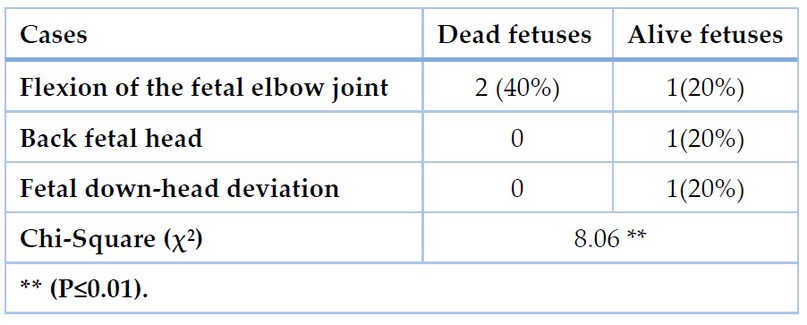
Table 2. Number and percentage of difficult male births with the anterior presentation of a fetus in heifer cows.
Table 3 shows the incidence of incomplete extension of fetal hind limbs and flexion of the hock joint as a cause for Dystocia in heifer cows and accompanied by posterior presentation of the male fetus.
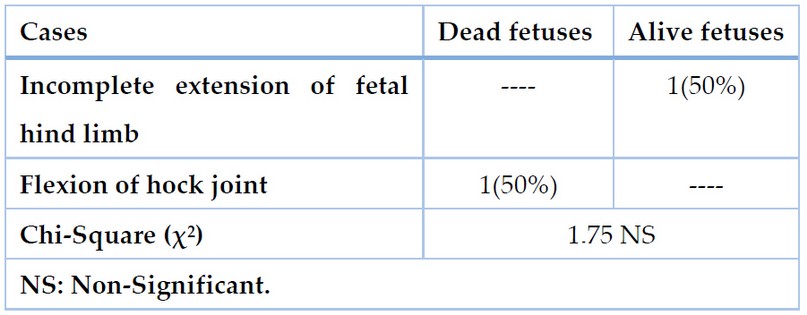
Table 3. Number and percentage of difficult male births with the posterior presentation of a fetus in heifer cows.
Table 4 reveals the Dystocia pattern accompanied by the problematic female birth. The percentage of dead fetuses was 33.34%, while the rate of alive fetuses was 66.66% for all practices of Dystocia.
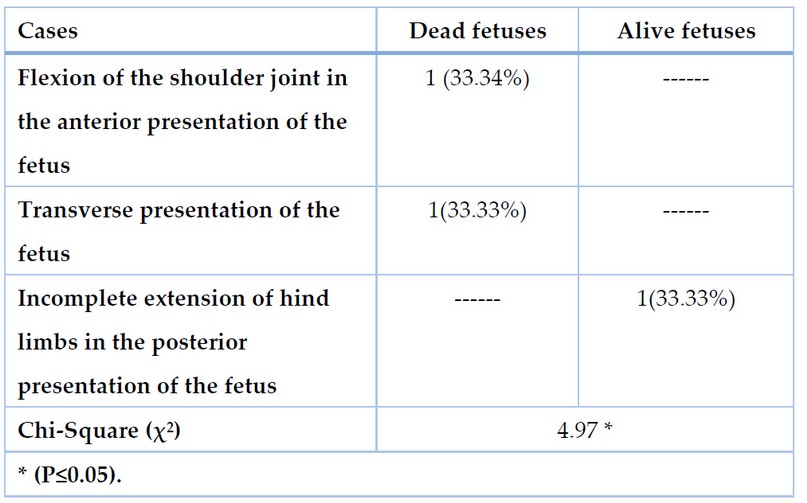
Table 4. Number and percentage of difficult female birth with the anterior, transverse and posterior presentation of a fetus in heifer cows.
Table 5 shows the types of Dystocia accompanied by male birth in multiparous cows; the number of alive fetuses was 6, while the number of dead fetuses was 2. These results indicate that multiparous cows are characterized by the complete size of the birth canal, and the probability of constriction of the birth canal is very low; consequently, the incidence of the dead fetus is lower than in heifer cows, and all cases of flexion of elbow joint of male births were alive, besides to the male births with fetal head down deviation and back fetal head from forelimbs that were alive as well 17,27,28,30,31,32. The incidence of flexion of the fetal elbow joint as a cause of Dystocia was higher in comparison with another cause, and this may be related to the larger size of male calves besides to the wide chests of these calves and during the birth process with continuous uterine contractions leading to flexion of the elbow joints of the male calves 16,17, 28,32. As in the heifer cows, the incidence of transverse presentation in multiparous cows is infrequent and accompanied by dead fetus; it is the complicated presentation of the fetus and accompanied by male births and has enormous detrimental and threatening the viability of calf due to the lowering pelvis space 28,32,33,34,35.
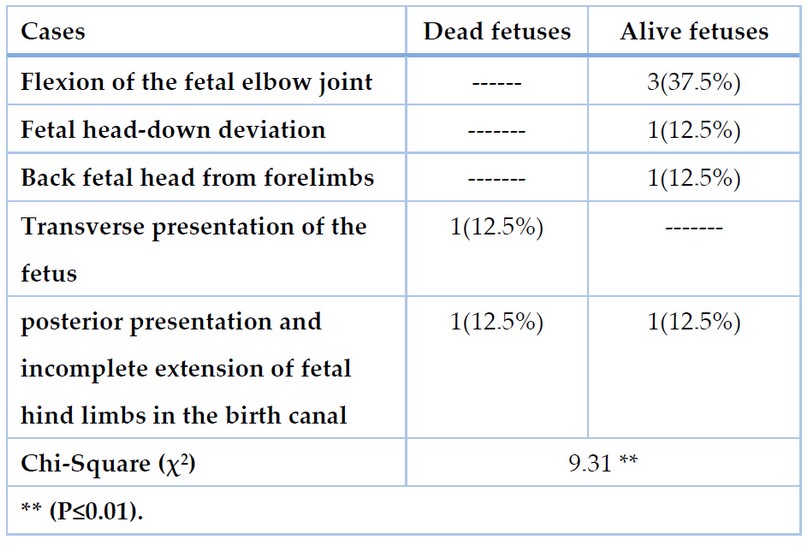
Table 5. Number and percentage of difficult male birth with a fetus's anterior, transverse and posterior presentation in multiparous cows.
Table 6 shows the number and percentage of the types of Dystocia and the number and percentage of alive and dead fetuses accompanied by female births in the multiparous cows.
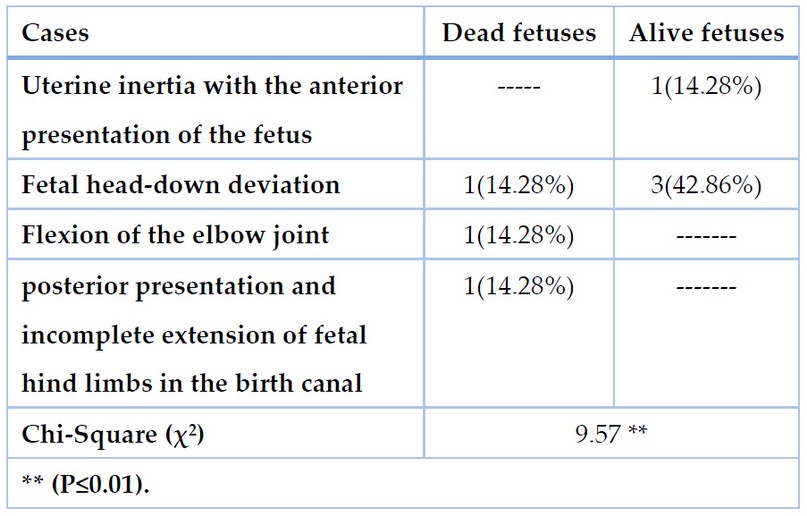
Table 6. Number and percentage of difficult female birth with the anterior and posterior presentation of a fetus in multiparous cows.
DISCUSSION
The results in table 1 disagree with many studies and references that have indicated that Dystocia is more common in heifer cows than in multiparous cows 5,6,11,12,13,14. This may attribute to the number of heifer cows involved in this study was little, and many cows engaged in this study were multiparous cows, and the care of owners was usually directed to the heifer cows at their first parturition, which led to a decrease in the probability of incidence of Dystocia in the heifer cows. However, Dystocia due to flexion of the elbow joint of the fetus's forelegs is a common condition, and its effect on the fetus's viability is variable 8,30,32. The incidence rates of the back fetal head and fetal down-head deviation as causes of Dystocia in heifer cows were 20%, in accord with many papers 15,16,17,18. The viability of the fetus due to these patterns of Dystocia was not influenced, and this may relate to the rapid and proper intervention by a veterinary practitioner, which led to the survival of the fetus viability, or the fetus size was relatively small 19,20,21. While in table 3 the findings of the study pointed out the occurrence of fetal death accompanied by the flexion of the hock joint and agreed with many previous papers and studies 2,5,11,16. The percentage of dead fetuses accompanied by the flexion of the hock joint in the posterior presentation in this study agrees with many researchers indicating that this percentage may reach 70% 16,18,19. The fetus may fail to rotate from the intrauterine position to the normal function of parturition resulting in Dystocia and may lead to death 13,16,18. Besides, the results of table 4 agreed with many papers and references have revealed that the overall incidence of Dystocia associated with female births tends to be less than in male births 22,23,24,25,26. This lower incidence of patterns or types of Dystocia accompanied by female births may belong to the smaller size of female calves and the lighter weight of these female calves compared to the male calves' births. Consequently, the incidence of Dystocia would decrease by 14,24,25,27.
The same table indicates that the birth accompanied by transverse presentation was dead, and this is in accord with many studies pointed out that the transverse presentation is infrequent. This presentation leads to fetal death 28,29,30. Table 5 also shows the percentage of posterior production of male calves with the incomplete extension of hind limbs in the birth canal in this type of cows, which was 25%, and in accord with many previous studies 8,32, 35, 36. It is well known that this type of Dystocia is less common compared to anterior presentation either in heifer cows or adult cows 28,30,32,36,37. The effect of this type on the fetus's viability is usually variable 18,19,28,36, and the study's results confirm this variability.
Moreover, The uterine inertia in Table 6 of this study is higher than in other studies 28,29,30 and lesser than in others 31,32. This discrepancy between the findings of the present study and those of others may be attributed to the nutrition status and or the breed of the cows evaluated. In this condition, although cervical dilation occurs and the fetus is in normal position and posture, it is not delivered due to lack or absence of uterine contractions besides the weak labor 7,33. The risk factors for uterine inertia and weak labor comprise hormonal imbalances such as reduced plasmatic estradiol concentration, elevated levels of oestradiol-17ß at parturition, or high ratios of cortisol to progesterone 33. These imbalances can lessen the expression of the receptors of oxytocin hormone in the uterus and change the preparation of the soft tissues, resulting in weak uterine contractions and dilatation of soft tissues 34. The percentage of fetal head deviation is 57.14% (42.86% for alive fetuses whereas 14.28% for dead fetuses. These results revealed that this type of Dystocia does not affect the viability of the fetus in multiparous cows, which indicates that the birth canal and pelvis cavity in multiparous cows are wide to the extent that this type of Dystocia does not influence the fetal life largely and the exception may be attributed to the relative oversized fetus that affected the viability of this fetus. As for the Dystocia due to the flexion of the elbow joint, the percentage of this type of Dystocia is agreed with other studies 8,28,35,36, and it is the effect on the viability of the fetus is variable, as mentioned in the discussion of this subject in the heifer cows. The percentage of posterior presentation in this table agrees with former studies 14,32,35, and its effect on the viability is variable, but in most cases of this type of Dystocia, the fetuses were dead.
CONCLUSIONS
Dystocia is a common case in both heifer cows and multiparous cows; the more common types of Dystocia are flexion of the elbow joint, head down deviation in the anterior presentation of the fetus, whilst the more common type of Dystocia is an incomplete extension of hind limbs in the birth canal in the posterior presentation of the fetus. The effects of these types of Dystocia on fetal viability in both heifer cows and multiparous cows are variable.
Conflict of Interest
We certify no conflict of interest with any financial organization regarding the material discussed in the manuscript.
Acknowledgments
The university of Diayla, Iraq, funded the study. I would like to thank all my colleagues and all the workers for helping us complete this study
REFERENCES
1. Mekonnen, M. & Moges, N.(2016) A review on Dystocia in cows. European Journal of Biological Sciences 8 (3): 91-100.
2. Yehualaw, B., Bassazin, G., Sewalem, M. & Mekonen, B.(2017) Review on the predisposing factors, Causes and economic impact of Dystocia in dairy cows. Journal of Reproduction and Infertility 8 (3): 72-81.
3. Bellows, R.A., Patterson D.J., Burfening P.J. and Phelps, D.A.(1987) Occurrence of neonatal and postnatal mortality in large beef cattle II. Factors Contributing to Calf Death, 9: 195-219.
4. Roberts, S.J., 2004. Veterinary Obstetrics and Genital disease. 2nd ed. New Delhi: C.B.S. Publishers and Distributors. 227-299.
5. Jackson, P.G.G.(2004) Handbook of Veterinary Obstetrics. 2nd ed. W.B. Saunders Elsevier Philadelphia. U.S.A.
6. Mee, J.F.(2008) Managing the cow at calving times. Irish Veterinary Journal, 41: 35-41.
7. Purohit, G.N., Barolia Y., Shekhar C. and Kumar, P.(2011) Maternal dystocia in cows and buffaloes: a review. Open Journal of Animal sciences, 1(2): 41-53.
8. Noakes, D.E., Parkinson, T.J. and England, G.C.W. (2001) Arthur's Veterinary Reproduction and Obstetrics. Eighth ed. London. Saunders. Elsevier. U.K.
9. Kumar, P. (2009) Applied Veterinary Gynecology and Obstetrics, International Book . Distributing Co. U.S.A.
10. SAS. (2012) Statistical Analysis System, User's Guide. 9.1th ed. SAS. nst. Inc. Cary. N.C. U.S.A.
11. Assefa, R. and Adugna, S.(2018) Causes, Economic impacts and Management of Dystocia in Dairy Cattle: A Review. Global Veterinaria 20(4): 153-163.
12. Jackson, P.G.G. (1995) Dystocia in the cow: In: Handbook of veterinary Obstetrics. W.B.Saunders Co. Ltd., Philadelphia, 30-69.
13. Mee, J. (2012) Prevalence and Risk Factors for Dystocia in Dairy Cattle with Emphasis on Confinement Systems. WCDS Advances in Dairy Technology vol., 24: 113-125.
14. Johanson, J. M., & Berger, P. J. (2003). Birth weight as a predictor of calving ease and perinatal mortality in Holstein cattle. Journal of dairy science, 86(11),3745-3755.
15. Purohit, G.N., Mehta, J.S. (2006) Dystocia in cattle and buffaloes. Aretrospective analysis of 156 cases. Vet Practitioner 7:31-40
16. Purohit, G.N., Kumar,P., Solanki, K., Shecker, C. and Yadav, S.P.(2012)Perspectives of fetal Dystocia in cattle and buffalo Veterinary Science Development 8: 31-42.
17. Mudasir, Q., Shukla, S.P., Noma, S.P, et al. (2010) Dystocia due to lateral deviation of the head and fetal emphysema in a she buffalo. Buffalo Bull 29:78-80.
18. Holland, M.D., Speer, N.C., Lefever, D.G. (1993) Factors contributing to Dystocia due to fetal malpresentation in beef cattle. Theriogenol. 39:899- 908.
19. Nix, J.M., Spitzer, J.C, Grimes, L.W., et al.(1998) A retrospective analysis of factors contributing to calf mortality and Dystocia in beef cattle Theriogenol., 49:1515-1523.
20. Yehualaw, B., Bassazin,G., Sewalem, M. and Mekonen, B.(2017). Review of the Peridisposing Factors, Causes and Economic Impact of Dystocia in Dairy Cows. Journal of Reproduction and Infertility 8 (3): 72- 81.
21. A.L.I., T. G.M. and AMIN, F.S.M.(2016) Causes and Treatment Dystocia In Cows In Sulaimani Province. Assiut Vet. Med. J. Vol. 62, No 48:152- 157.
22. Hansen, M.; Misztal, I.; Lund, M.S.; Pedersen, J.and Christensen, L.G. (2004) Undesired phenotypic and genetic trend for stillbirth in Danish Holsteins. J.Dairy Sci.,87: 1477-1486.
23. Meyer, C.L.; Berger, P.J.; Koehler, K.J.; Thompson, J.R.and Sattler, C.G. (2000) Interactions among factors affecting stillbirths in Holstein Cattle in the United States. J.Dairy Sci., 83: 2657-2663.
24. Mee, J.F. (1991) Perinatal calf mortality-recent findings. Irish Vet. J., 44: 80-83.
25. Heins, B.J.; Hansen, L.B.and Seykora, A.J. ( 2006) Calving difficulty and stillbirths of pure Holsteins versus crossbreds of Holstein with Normande, Montbeliarde, and Scandinavian Red. J. Dairy Sci., 89:2805-2810.
26. Ghavi Hossein-Zadeh, N.; Nejati-Javaremi, A.; Miraei-Ashtiani S.R. and Kohra. H. ( 2008)An observational analysis of twin births, calf stillbirth, calf sex ratio, and abortion in Iranian Holsteins. J. Dairy Sci., 91:198-4205.
27. Wehrend, A., Reinic, T., Herfen, K., Bostedt, H. (2002) Fetotomy in cattle with special references to post-operative complications: an evaluation 131 cases. Dtsch Tierarztl Wochenschr 109:56-61.
28. GOLI, M. (2018) Incidence of different types of Dystocia in different season of the year and parities in Iranian Holstein dairy cows. Bulgarian Journal of Veterinary Medicine, 21 (3): 336–346.
29. Phogat, J.B.; Bugalia, N.S. and Gupta, S.L. (1992) Incidence and treatment of various forms of Dystocia in buffaloes. Indian Journal of Animal Reproduction 13(1):69-70.
30. Noakes, D.E.; T.J. Parkinson and G.C.W. England (2009) Veterinary Reproduction and Obstetrics. Ninth Ed. Saunders Elsevier, Uk.
31. Fazili, M.R. and Syed, F. (1999) Caesarean section in cows: a study of thirteen cases, Journal of Bombay Veterinary College 7(1-2):47-48. .
Suwaid, A. H. .; Rashid, M. A. .; Taha, M. M. . Genetic Analysis For Combining Ability And Estimation Of Some Genetic Parameters Of Yield And Its Components In Maize Using Half Diallel Cross. ). Journal of Life Science and Applied Research. 2020, 1, 60-64..
32. Emad H. H. Alsalmany , TH. T. Mohammed. Effect of adding natural zeolite and vitamin E to diets of laying hens ( Lohman Brown) on some physiological traits and productive performance during hot weather. Revis Bionatura .2022;7(4) 12. http://dx.doi.org/10.21931/RB/2022.07.04.12.
33. Ghavi Hossein-Zadeh, N. (2013) Effects of main reproductive and health problems on the performance of dairy cows: a review. Spanish Journal of Agricultural, Research 2013 11(3):718-735.
34. Majeed, A., Ali, J.B.andTaha, M.B.(1989) A preliminary study on Dystocia in local breed Iraqi cattle.Prev Vet Med.,7:219-23.
35. Singh, M. and Nanda, A.S. (1995) Incidence of various types of Dystocia in buffaloes.Journal of Research, Punjab Agricultural University 32: 82- 83.
36. Meijering, A. (1984) Dystocia and stillbirth in cattle: a review of causes, relations and implications Livestock Prod Sci., 11:413-77.
Received: January 15, 2023 / Accepted: February 25, 2023 / Published:15 March 2023
Citation: Mahmood, M.Y.; Khudhair, N.Y.; Rasheed, Y.M. Heifers and multiparous cows are affected by Dystocia and its implications on the viability of the pregnancy. Revis Bionatura 2023;8 (1) 82. http://dx.doi.org/10.21931/RB/2023.08.01.82
